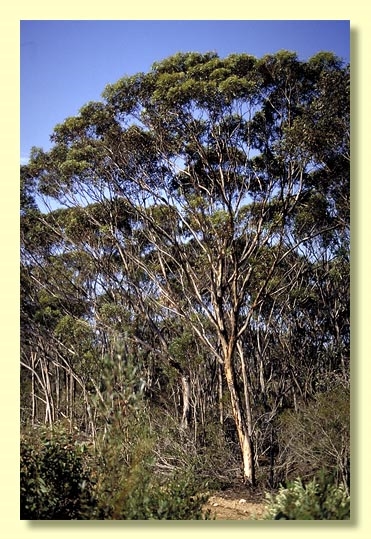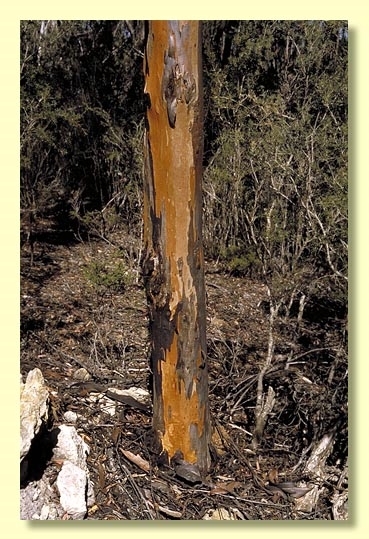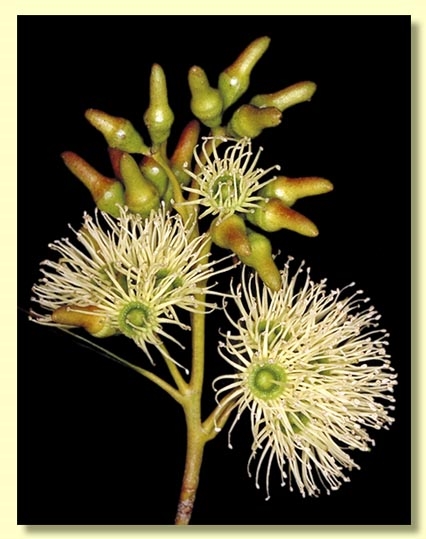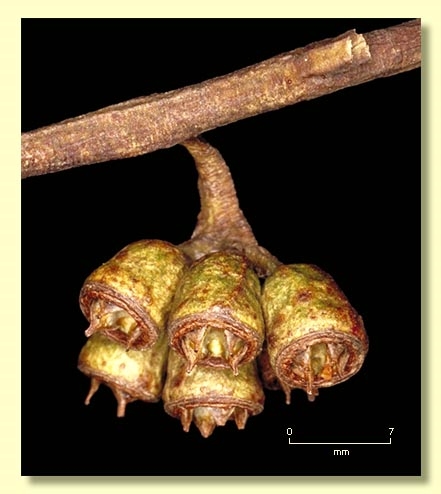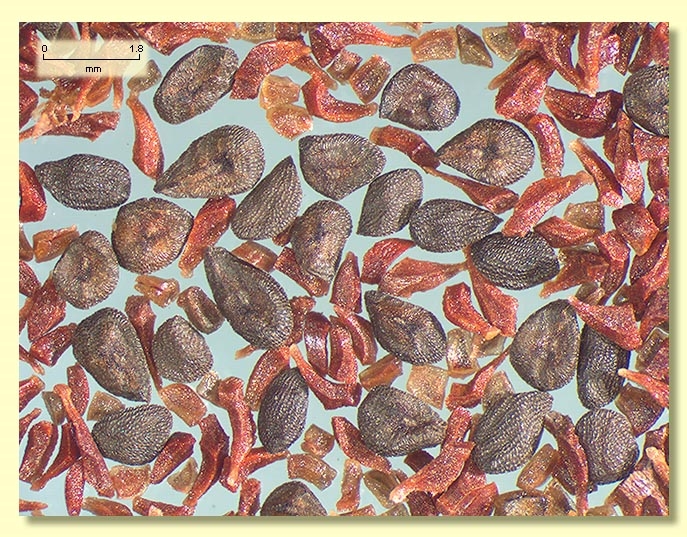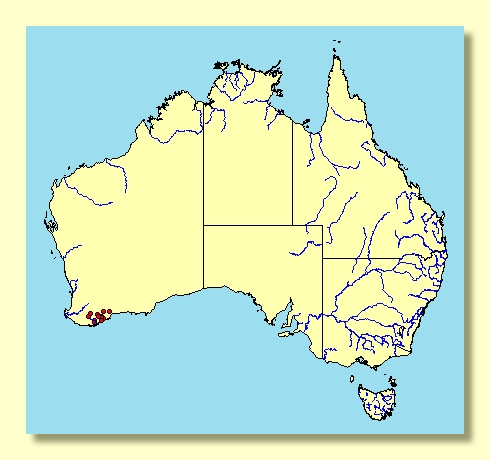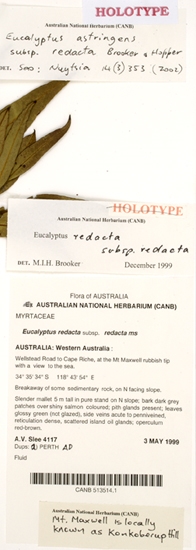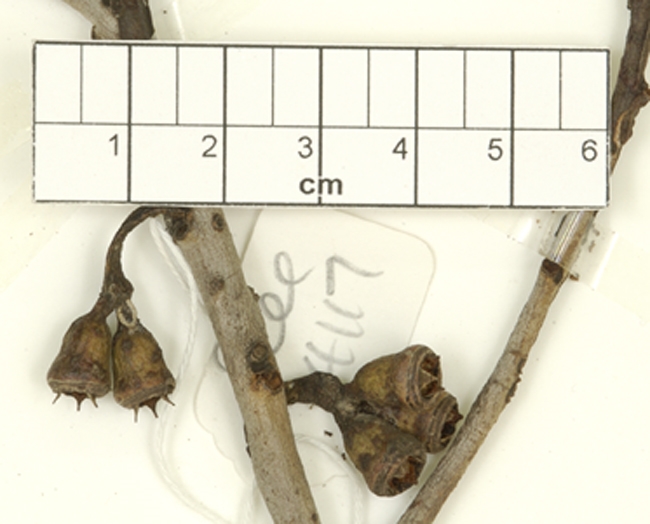Eucalyptus | Symphyomyrtus | Bisectae | Glandulosae | Erectae | Pedicellatae
Euclid - Online edition
Eucalyptus astringens subsp. redacta
Bark smooth throughout, grey over yellow then shiny bronze to salmon-coloured.
Branchlets with oil glands in the pith.
Juvenile growth (coppice or field seedlings to 50 cm): not seen.
Adult leaves alternate, petioles 0.8–2.5 cm long; blade lanceolate, rarely falcate, 5–10.5 cm long, 1–2.5(3) cm wide, base tapering to petiole, margin entire, apex pointed, concolorous, green, at least slightly glossy, side-veins at an acute or wider angle to midrib, reticulation moderate to dense and broken, intramarginal vein present, oil glands numerous, island and intersectional.
Inflorescence axillary unbranched, spreading to erect, rarely pendulous, peduncles flattened or only slightly so, 0.8–2.5(3) cm long, buds 7 per umbel, pedicellate (pedicels 0.2–0.9 cm long). Mature buds elongated-ovoid (1.0–1.5(2) cm long, 0.3–0.6 cm wide), flared at the join of operculum and hypanthium, scar present (outer operculum lost early), inner operculum bluntly horn-shaped, ca 1.5–2 times the length of the hypanthium, stamens erect, anthers oblong, versatile, dorsifixed, dehiscing by longitudinal slits, style long and straight, stigma blunt, locules 3 or 4, the placentae each with 4 vertical rows of ovules. Flowers creamy white to pale lemon, rarely pink to red.
Fruit erect, spreading or rarely downturned, pedicellate (pedicels 0.1–0.4 cm long), cupular to obconical or campanulate, 0.7–0.8 cm long, 0.6–0.8 cm wide, disc level at first then descending, valves 3 or 4, held at rim level or exserted.
Seeds blackish brown, 0.8–2 mm long, ovoid to flattened-ovoid, dorsal surface shallowly reticulate, hilum ventral.
Cultivated seedlings (measured at node 10): cotyledons Y-shaped (bisected); stems rounded in cross-section; leaves always petiolate, opposite for 4 to 6 nodes then alternate, ovate, 5–7.5 cm long, 4–6 cm wide, dull, grey-green.
Eucalyptus astringens is a mallet species endemic to Western Australia, distributed south-east of Perth from Brookton, south to near Albany and east to Hopetoun. The adult leaves are glossy green.
It belongs in Eucalyptus subgenus Symphyomyrtus section Bisectae subsection Glandulosae because the buds have an operculum scar, cotyledons are bisected and branchlets have oil glands in the pith. Within this large subsection (ca 80 species) E. astringens is closely related to a group of mallets and mallees (series Erectae subseries Pedicellatae) recognised by the glossy green leaf surface, leaves with many oil glands but not obscuring the secondary venation, peduncles long and flattened or terete, inflorescences spreading to pendulous and buds with operculum longer than the hypanthium and erect stamens arising from a narrow staminophore.
E. astringens is distinguished from its relatives by its mallet habit, smooth bark and stubby, blunt buds with operculum only one to two times the length of the hypanthium and its campanulate fruit. E. thamnoides has similar buds but differs in the consistent mallee habit. Other related species, viz. the rough-butted tree of freshwater creeks and depressions, E. occidentalis, rough-barked mallee E. aspratilis, smooth-barked mallee E. sporadica and rough-butted tree of saline sites, E. sargentii, all have more slender buds with elongated opercula.
There are two weakly distinguished subspecies:
E. astringens subsp. astringens
This subspecies is a taller mallet with buds usually longer than 1.5 cm. It is always found on well-drained lateritic breakaways and occurs from Brookton to near Albany, and east as far as Hyden and Newdegate.
E. astringens subsp. redacta
A small mallet with smaller buds and fruits than in subsp. astringens (buds usually shorter than 1.5 cm), occurring in southern subcoastal areas between Kambellup, Jerramungup and Ravensthorpe exending to the coast between Albany and Bremer Bay; on lateritic breakaways.
subsp. redacta: Latin redactus, reduced, referring to the habit, buds and fruit compared to subsp. astringens .

